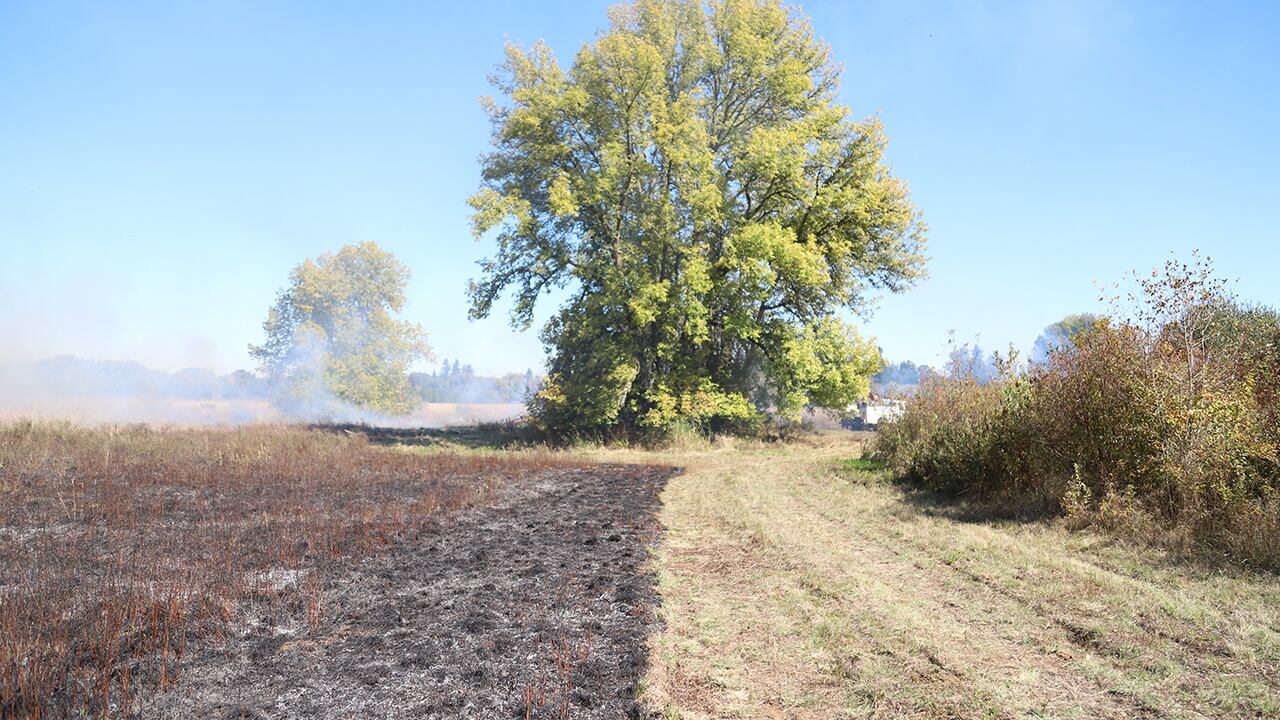In May 2019, Merv George Jr. stood onstage at the Camelot Theatre in Talent, Ore., in front of a few dozen locals, and issued a warning.
If Oregon is going to prevent massive wildfires, it's going to have to start lighting a lot of little ones.
George, 47, is the U.S. Forest Service supervisor for the Rogue River-Siskiyou National Forest on the Oregon-California border. He'd come to the small Southern Oregon town to talk about controlled burns—small fires deliberately set in order to clear underbrush, creating more space between trees to prevent fires from spreading rapidly.
As a member of the Hoopa Valley Tribe, the concept of fighting fire with fire is part of George's heritage. It's a common practice in other parts of the country, where the terrain is less rugged.
But George says it's not happening in Oregon nearly enough as it should.
That's why he's spent much of his career giving lectures and interviews to educate the public on the practice of "prescribed fires."
A stocky, tattooed father of four, George peppered his talk with endearingly corny dad jokes about Indigenous life in the days before Walmart and Uber. But his main point is serious.
"I know for a fact that when you remove low-intensity, prescribed fires from the landscape," he told the audience at the Camelot while wearing his beige and green Forest Service uniform, "you're adding to the fuel problem."
A year later, George's talk now seems prophetic.
In early September, the Almeda Fire, which started in Ashland and spread to over 3,000 acres, just about burned Talent off the map. Entire neighborhoods were reduced to ash, leaving nothing but gnarled trees for blocks on end. The Camelot is among the few buildings left standing.
The wildfires that swept across Oregon last month, incinerating 1 million acres of land, displacing tens of thousands of residents, and choking the Willamette Valley with hazardous smoke, were described as a "once-in-a-generation event" by Gov. Kate Brown.
But megafires—blazes that consume more than 100,000 acres—are becoming an almost annual occurrence.
For George, the answer to slowing them is obvious: prescribed burns, and lots of them. And he wants Oregon's Indigenous communities to help.
For generations, Native American tribes used small fires to manage the forestland they occupied. But over the past century, the Forest Service has taken control of most of the nation's forests, replacing Indigenous land stewardship with an approach that favors fire suppression over prevention.
Right now, tribes in Oregon can get permission to conduct prescribed burns on their own reservations, but the process is bogged down by bureaucracy, causing them to often miss crucial seasonal windows.
Many tribes, George says, would relish the opportunity to play a part in managing the ceded lands off their reservations.
The concept of prescribed fires in general have several factors working against them, including the unpopularity of burns and the attendant smoke among Oregonians and the fact that the timber industry would much rather cut trees than burn them.
The regional Forest Service says it wants to expand prescribed burns in Oregon, but funding suppression efforts remains a priority because it ensures the safety of firefighters battling blazes.
But there's a growing consensus among experts that controlled burns are crucial for curtailing megafires. In a study released at the beginning of 2020, environmental scientists at Stanford University called for "a colossal expansion of fuel treatments" and declared that "fundamental shifts in prescribed-burn policies…are needed to address wildfires in California and worldwide."
If that doesn't happen, George predicts Oregonians will continue to watch homes and beloved natural areas go up in flames year after year.
"It's not a foreign concept to those of us that come from the tribal communities," he says. "It's just what you do. It's why you're put on this earth—to take care of the landscapes that take care of you."

At the start of every workweek, George gets into his pickup truck, throws on an eclectic mix of gangsta rap, classic country and techno, and drives three hours from his home on the Hoopa Valley Reservation in Northern California to his office in Medford, Ore.
Growing up, George never imagined he'd end up working for the Forest Service. He remembers the green trucks that rolled through the reservation during the logging boom of the 1970s and '80s, driven by officials who'd never even make eye contact with anyone who lived there.
"They always made you feel unwelcome in your own forest," he says. "I just never understood that. Like, what's the deal here? Are they all in a bad mood? Do they all just hate Indians?"
When he became forest supervisor for Six Rivers National Forest, just east of California's famous redwoods, in 2014—the first Native American to ever hold the position in California—he hoped to improve the relationship between the Forest Service and Indigenous tribes.
Gregarious and decidedly nonconfrontational, George sees himself as a sort of cultural diplomat. But as a son of a Hoopa tribal ceremonial leader, he recognized the Forest Service had a long history of disenfranchising tribes, preventing Indigenous communities from accessing and cultivating the lands that sustained their entire way of life.
"You talk to any tribal elder," George says, "and there was always a sense of frustration that the Forest Service never let them do their cultural burns."
For centuries, Indigenous tribes used intentional, low-intensity burns to shape the landscape.
In the Willamette Valley, fire cleared understories of brush and poison oak for easier passage, proliferated camas seeds, and removed the coating from tarweed pods so they could be harvested and ground into flour.
Everywhere along the West Coast, managing the land with fire produced a common benefit, as thinner forests are much less likely to become fuel for megafires.
But cultural burnings have been viewed as essentially arson since at least 1850, when California outlawed intentional burns as part of the Act for the Government and Protection of Indians.
Conservationists opposed them, too. Naturalists like John Muir helped lodge the image of a "wild West" undisturbed by humans in the American consciousness. To this day, wilderness designations—which, according to the Wilderness Act of 1964, preserve lands "untrammeled by man"—are a major focus of conservation groups across the nation.
"Wilderness designations sort of rubbed a lot of Indian country the wrong way, because what a foreign concept—you're somehow protecting something by neglecting it," George says. Now, "our forests are completely unnatural. There are way too many trees and way too much brush."
George says it's still much easier to get funding for fire suppression than it is for projects that could prevent costly fires from happening in the future.
"We haven't turned a corner yet in our country," he says. "For some reason, it's always easier for our agency to find the money to put fire out, when it's often more difficult to fund the organization to prevent fire."
Stephen Baker, a spokesperson for the Forest Service, says the agency wants to expand its prescribed burning programs. But funding for fire suppression, which takes up about half of the agency's budget, still takes precedent.
"The issue is expanding [prescribed burns] and doing it on a bigger scale," he says. "The challenges we face from wildfires are bigger than one agency."

George has seen some success in establishing burn programs that involve Indigenous communities. At Six Rivers, he partnered with the Karuk Tribe to conduct burns on its ancestral lands. In Rogue River-Siskiyou, which he came to supervise in 2018, he's working with the Coquille to create a joint environmental impact team to oversee more burn projects.
Along with working to repair generations of injustice, George believes collaborating with tribes can address the Forest Service's capacity issues. But it takes time and effort to build trust between tribes and an agency that has historically worked to disenfranchise them.
"There's not a cookie-cutter, one-way approach to get there," he says. "Every local forest and tribe has a different dynamic and different histories, so you have to navigate all of that in order to get to all of those positive outcomes."

As the fire prevention manager for the Confederated Tribes of Grand Ronde, Colby Drake is eager to take on more off-reservation partnerships for prescribed burn projects.
Even for burns on the Grand Ronde's reservation, just west of Oregon City, Drake's projects are mired in red tape. To conduct a burn, he has to coordinate with a long list of government oversight agencies and run the plan up through the Bureau of Indian Affairs, which manages all tribal lands.
The process has to start months in advance, but the weather can shift at the last moment, potentially causing Drake's team to get rained out of their chance to burn for the whole season.
For more burns to happen, Drake says tribes need more power to make their own decisions and greater access to their ancestral lands off the reservation.
"It just makes sense," he says. "What better group of people to be putting fire on their ceded lands than the Indigenous group that's here?"
Drake is encouraged by a recent spike in government agencies and nongovernmental organizations asking the Grand Ronde for help with land management. Last fall, in partnership with Metro, Drake led a controlled burn in the Quamash Prairie Natural Area near Tigard.
"It's just looking for that one extra push to be like, OK, we're here, you guys, it's time to do or die," he says. "Are we going to move forward and get these projects done, or are we just going to sit back and let this happen every summer? For lack of a better term, shit or get off the pot."
But George isn't waiting for legislators or government agencies to come around.
He plans to continue to rally public support for what he believes is true—fire exclusion doesn't work and Indigenous land management does. He's hoping his district's new partnership with the Coquille Tribe will allow the Rogue River-Siskiyou to conduct more burns and reduce more hazardous fuels in the wilderness.
Even with the Coquille's help, though, it won't be a quick fix.
"It's taken us 100 years to get here," says George. "It's going to take a long time to get our forests healthy again."
But that's just all the more reason to act quickly.
A few weeks ago, George drove west from Medford toward Cave Junction to see what was left in the wake of the Slater Fire. When he stopped to look south toward the California border, he saw nothing but scorched earth for miles.
"I guarantee you that looks worse than any project I've ever proposed," he says. "When you incinerate an ecosystem, you know you have done something wrong. I'm trying to do my best to prepare our landscapes to see fire again so that doesn't happen."

